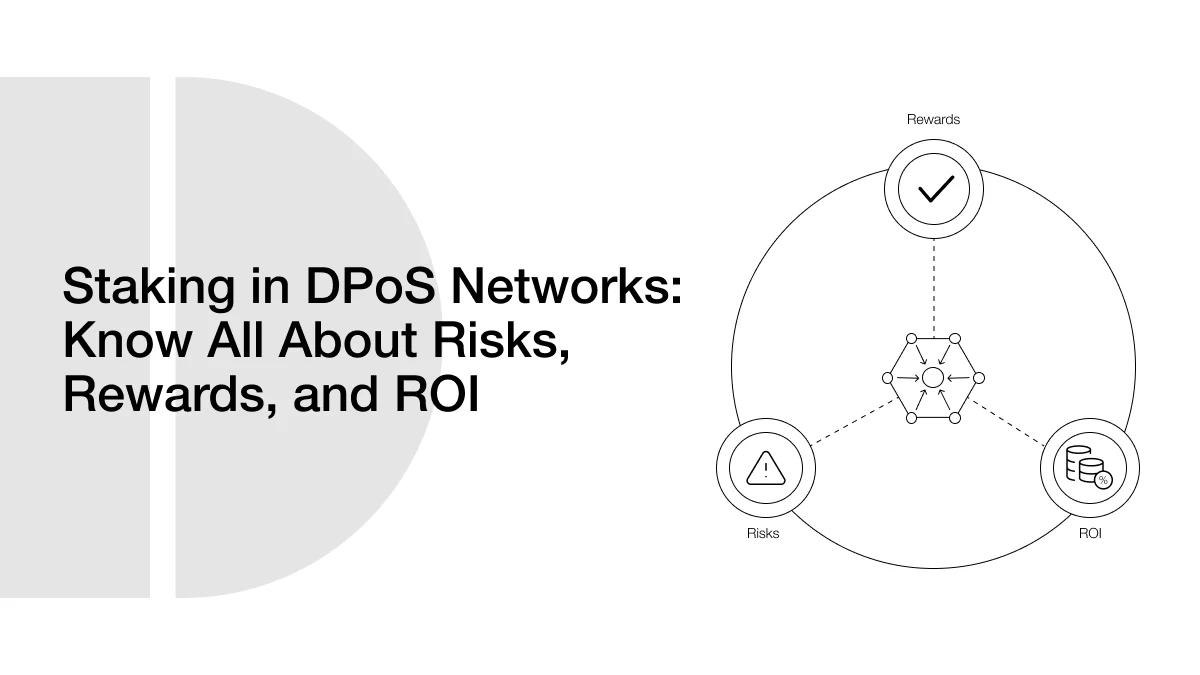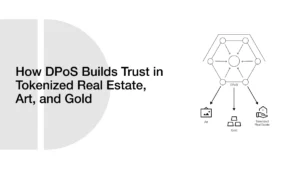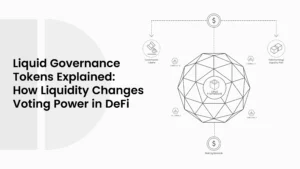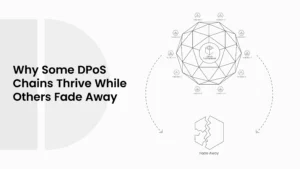Staking in DPoS Networks: Know All About Risks, Rewards, and ROI

Delegated Proof of Stake (DPoS) networks offer a compelling blend of speed, scalability, and participation by empowering token holders to delegate voting power to trusted validators. Academics examining blockchain efficiency are increasingly studying this consensus model, which accelerates transaction verification and reduces energy consumption.
- Understanding DPoS Delegation
- Rewards, ROI, and the Economics of Staking
- What Drives Staking Returns?
- Validator Selection and Reward Distribution
- Why External Yields Matter to DPoS Participants
- Risk Comparison Between Traditional PoS and DPoS
- Risk Vectors in DPoS
- Comparison of Staking ROI and Validator Power
- Staking in Practice: The Steemit Takeover (TRON, 2020)
- Staking in Practice: EOS Forks to the ENF (2021)
- Economic Interactions and External Yields
- Innovations: Liquid and Restaking Derivatives
- Toward Balanced Staking Frameworks
- Conclusion
- FAQs
- Glossary of Terms
- References
Scholarly research emphasizes the economic influences impacting staking in DPoS systems. Research indicates a significant trade-off in Proof of Stake frameworks between enhancing validator quality and promoting network engagement (Oderbolz et al., 2024). Additionally, it models how different yields, such as those seen in DeFi, may drive stakers to reallocate capital, thereby affecting network security (Chitra, 2019). These insights provide a framework for comprehending the intricate rewards, risks, and return systems in DPoS settings.
Understanding DPoS Delegation
In Delegated Proof of Stake, holders of tokens choose a group of delegates to create blocks and verify transactions for them. In contrast to conventional PoS systems that permit every staker to directly lock tokens, DPoS assigns a set number of active nodes, which are typically chosen through community voting, that take turns as support changes or penalties are enforced. This framework enhances throughput but concentrates decision-making authority within a limited group.
The fundamental idea focuses on delegation rather than direct involvement of stakeholders. Token holders allocate their tokens to representatives who receive rewards and subsequently share a portion of those rewards with the delegators. This system encourages wide participation, including from those with small balances, while maintaining network efficiency. Recent research suggests that improvements, such as community-aware voting systems, can strengthen decentralization and reduce harmful activities (Li et al., 2023).
Rewards, ROI, and the Economics of Staking
Staking in Delegated Proof of Stake (DPoS) systems can provide significant rewards, although these benefits depend on several variable factors. To understand your potential earnings and the factors that affect your return on investment (ROI), you need to analyze how rewards are created, how they are allocated, and how external factors influence individuals’ choices related to their tokens.
What Drives Staking Returns?
Staking rewards in DPoS networks typically come from two main sources:
- Block Rewards – These are new tokens created and given to validators as part of the network’s inflation model.
- Transaction Fees – Validators collect fees from users for sending or interacting with the blockchain.
Some networks may also offer bonuses for early adopters or integrate with DeFi protocols to increase yields. But in general, the total staking return is based on how many rewards are issued and how many people are staking. If only a few people stake, the rewards are split among fewer participants, resulting in a higher ROI. But when more people join in, the same reward pool gets divided more thinly.
Validator Selection and Reward Distribution
Block rewards in DPoS networks typically derive from inflationary issuance, transaction fees, and, in some cases, yield-sharing innovations in DeFi layers. Returns for delegators depend on the network’s tokenomics, the performance and reliability of the chosen delegate, and the reward structure defined by each validator.
Academic analysis notes two notable factors. First, optimal staking design must strike a balance between having a smaller number of highly reliable validators and a larger set of validators that support decentralization (Oderbolz et al., 2024). Second, complementary financial opportunities exert significant influence. When returns from alternatives, such as on-chain lending or yield farming, exceed staking yields, rational actors tend to withdraw capital from the DPoS network (Chitra, 2019). Thus, staking returns must be calibrated not only to internal network goals but also to the broader financial market.
Why External Yields Matter to DPoS Participants
Staking returns are not isolated from other factors. Delegators tend to be financially astute, frequently assessing staking rewards against alternative options, particularly in DeFi, actual interest rates, or yield farming.
For example:
- If a DPoS network provides 5% staking rewards, while a DeFi protocol provides 12% APY, users might choose to unstake and transfer their funds.
- If global interest rates increase, the cost of holding tokens goes up, which may lead to a decrease in staking participation.
Research in academia (e.g., Chitra, 2019) indicates that when external returns exceed staking incentives, capital withdraws from staking, diminishing validator support and compromising network security. This establishes a cycle where diminished staking leads to reduced security, which undermines trust and causes even more individuals to depart.
This is the reason that effectively designed DPoS systems need to adjust inflation rates, commission structures, and reward models in a dynamic manner. They need to provide appealing returns, or they may lose their staking users to more enticing yield platforms.
Risk Comparison Between Traditional PoS and DPoS
| Risk Type | PoS | DPoS |
| Centralization Risk | Moderate | High (due to fewer validators) |
| Energy Efficiency | High | High |
| Governance Flexibility | Low (on-chain slow) | High (but subject to capture) |
| Slashing & Penalties | Common | Less common |
| Voter Participation | Low–Medium | Medium–High (due to delegation) |
Risk Vectors in DPoS
Several security and economic risks arise within staking mechanisms in DPoS networks. A primary concern is centralization. A small number of popular or well-resourced validators may accumulate delegations, creating concentration risks and potentially leading to censorship scenarios.
This structural design also poses attack vulnerabilities. With fewer active nodes, efforts to rewrite chain history become more feasible. Even when slashing or rotation mechanisms are in place, they may not fully prevent long-range or collusion-based attacks.
Financially, staking dynamics can be unstable. If staking yields fall below returns available through other strategies, delegators may withdraw, triggering sharp declines in network security and validator reliability. Models by Chitra (2019) formalize this feedback loop, demonstrating how yield competition can destabilize Proof-of-Stake systems (Chitra, 2019).
Recent proposals, such as quadratic voting or credit-weighted delegation, aim to reduce concentration, improve fairness, and enhance resilience in validator selection (Lei et al., 2025). Additionally, simulations of DPoS systems with enhanced reputation metrics indicate higher node participation and improved resistance to low-effort delegation (Wei et al., 2024).
Comparison of Staking ROI and Validator Power
| Network | Average Staking ROI | Number of Active Validators | Stake Controlled by Top 3 (%) |
| TRON | 5–6% | 27 | 30–40% |
| EOS.IO | 3–5% | 21 | 25–35% |
| BitShares | 1–2% | ~25 | 20–30% |
This table illustrates the variation in ROI and validator centralization across different DPoS networks.
Staking in Practice: The Steemit Takeover (TRON, 2020)
In early 2020, Justin Sun, the founder of TRON, leveraged his TRX holdings to affect the governance of the Steemit blockchain, which operates on a DPoS model. Through the mobilization of centralized exchange voting power, he managed to remove current Steemit validators and quickly substitute them with TRON-aligned representatives within a few hours.
ALSO READ: How Bitshares, EOS, and TRON Implement DPoS Differently
This event sparked major backlash in the crypto community and highlighted a key vulnerability in DPoS:
Large stakeholders can quickly shift control, overriding community decisions if there are no safeguards in place.
The Steemit situation is one of the most evident instances of how token-weighted voting can be exploited in environments with low participation or distribution.
Staking in Practice: EOS Forks to the ENF (2021)
In late 2021, the EOS community took a daring step. Disillusioned by unmet commitments and stagnation from original supporter Block.one, key stakeholders and block producers ended their relationship and initiated the EOS Network Foundation (ENF).
This marked a rare moment in blockchain history:
A DPoS ecosystem successfully reclaimed governance from a founding entity and created a more transparent, community-run network.
The ENF now leads EOS upgrades and manages the treasury. This indicates that when active governance mechanisms are in place, DPoS communities can adapt and restructure their leadership in response to failure.
Economic Interactions and External Yields
Staking does not occur in isolation from the broader financial ecosystem. When traditional interest rates rise, academic models indicate that staking participation decreases as the opportunity cost increases. Similarly, high returns in DeFi protocols can draw capital away from DPoS systems.
This interplay means staking design must anticipate external competition. Networks that fail to adjust inflation rates, reward distributions, or delegation rules in response may see declining security or staking engagement. Oderbolz et al. (2024) emphasize the need to balance validator quality and user incentives to maintain dynamic security and adoption (Oderbolz et al., 2024).
Innovations: Liquid and Restaking Derivatives
A growing trend involves enabling staked assets to earn additional yields through derivatives. Liquid staking tokens, such as tokenized staked ETH, allow capital to remain active in DeFi while securing the network. Models reveal that though these tools can boost returns, they introduce peg risk and interdependence, potentially destabilizing both derivative and base-layer networks.
Layered staking and restaking schemes, such as those demonstrated in EigenLayer, further multiply yield opportunities by stacking security obligations. This can significantly amplify the returns on delegation, but it also deepens systemic risk exposure and heightens the fragility of liquidation and collateral.
Combining reward amplification with strong economic incentives reflects real-world circumstances in DPoS networks. Stakeholders must evaluate yield upside against network exposure and complexity.
Toward Balanced Staking Frameworks
Effective DPoS protocols must strike a balance between scalability, security, and capital efficiency. Design levers include reward structures, validator selection rules, slashing conditions, delegation incentives, and integration with derivative layers.
Academic frameworks recommend reward curves that favor smaller validators to counter wealth-based concentration and promote fairness (Norman et al., 2025). Metrics‑based delegation schemes, such as credit‑weighted voting or quadratic delegation, aim to improve selection equity.
Slashing mechanisms, reputation tracking, and time-based lockups create accountability and discourage misbehavior or rapid withdrawals. However, these measures add complexity and risk, hampering network flexibility.
The challenge intensifies when multi-chain, multi-layer staking emerges. Designers must align governance tools with systemic clarity, ensure peg stability in liquid staking derivatives, and monitor cross‑protocol risk exposures.
Conclusion
Delegated Proof of Stake staking offers a potent blend of efficiency, participation, and financial incentives across blockchain ecosystems. Its delegation model enables high throughput while involving everyday token holders. Rewards are meaningful for those who choose strong, well‑performing delegates and can shift dramatically as external yields shift.
Nonetheless, centralization risk, financial instability driven by yield competition, and complex exposure from staking derivatives pose challenges. Poorly calibrated designs may foster concentration, fragility, and systemic vulnerabilities.
For developers, crafting resilient DPoS frameworks means dynamically aligning tokenomics with validator diversity, reward fairness, and rigorous security defaults. Research should further explore the real-world effects of multi‑layer staking, derivative protocols, and governance innovation.
Ultimately, staking in DPoS networks depends on achieving a nuanced equilibrium that supports validator integrity, market-linked incentives, and modular growth. As these systems continue to gain adoption, they will succeed only if their economic architecture strikes a balance between reward, decentralization, and strategic adaptability.
FAQs
- What is Delegated Proof of Stake (DPoS)?
DPoS is a blockchain consensus mechanism where token holders vote for a small number of validators (called delegates) to validate transactions and produce blocks on their behalf.
- How do staking rewards work in DPoS networks?
When you delegate your tokens to a validator, they use your voting power to stay elected. If they successfully validate blocks, they earn rewards and share a portion of them with you.
- Can I lose my tokens by staking in DPoS?
Generally, your tokens are not at risk of being lost in DPoS, unlike some PoS systems with slashing. However, poor-performing validators may deliver lower returns, or their actions could weaken network trust.
- Why are DPoS networks faster than PoW or traditional PoS?
DPoS limits the number of active validators, making it easier to reach consensus quickly. This reduces latency and enables higher transaction throughput.
- What are the risks of DPoS staking?
Major risks include centralization (concentrating too much power in a few hands), low validator turnover, and competition from higher-yield DeFi platforms that can compromise network security when stakers exit.
Glossary of Terms
Delegator: A token holder who assigns voting power to a validator without running a node.
Validator/Delegate: A trusted node chosen to validate blocks and secure the network.
Staking: The act of locking up tokens to support the network and earn rewards.
Block Reward: New tokens or fees given to validators for producing blocks.
Slashing: A penalty system that takes tokens from validators for bad behavior (rare in DPoS).
Liquid Staking: A method allowing stakers to receive a token that can be traded or used in DeFi.
Restaking: Using the same staked assets to secure multiple protocols or layers.
Peg Risk: The risk that tokenized assets (e.g., staked tokens) lose their intended value parity.
References
- Oderbolz, N., Marosvölgyi, B., Hafner, M. (2024). Towards an Optimal Staking Design: Balancing Security, User Growth, and Token Appreciation. arXiv. (fastercapital.com, arxiv.org)
- Chitra, T. (2019). Competitive equilibria between staking and on‑chain lending. arXiv. (arxiv.org)
- Li, W., Deng, X., Liu, J., Yu, Z., Lou, X. (2023). Delegated Proof of Stake Consensus Mechanism Based on Community Discovery and Credit Incentive. Entropy (mdpi.com)
- Lei, T. et al. (2025). An enhanced DPoS consensus mechanism using quadratic voting. Blockchain Journal(pdf.elspublishing.com)
- Wei, Y., Xu, Q., Peng, H. (2024). DL‑DPoS: Deep link–delegated Proof of Stake. Scientific Reports (nature.com)
- Norman, M., Brown, S., Pai, M., Smith, L. (2025). SPARC: Staking Performance And Reward Coopetition. arXiv.(arxiv.org)




